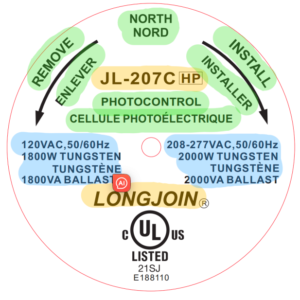What is the Zhaga Photocell Industry and its Significance?
Introduction
The Zhaga Photocell Industry represents a pivotal force in the dynamic landscape of modern lighting. It’s like giving lights a brain!
At its core, Zhaga Photocell technology integrates sophisticated sensors into lighting fixtures, enabling automatic control based on natural light conditions. This innovation holds immense relevance, particularly in the context of smart lighting and energy efficiency initiatives.
As cities grow, energy efficiency becomes paramount, and the demand for smart, interconnected lighting solutions intensifies. The Zhaga Photocell Industry is all about making outdoor lights smarter. These dusk to dawn photocell can sense how bright or dark it is outside and adjust themselves accordingly.
Read the article to further understand the significance of the Zhaga photocell industry in the contemporary world.

What is the Zhaga Photocell Industry?
Zhaga stands for “Zurich Agreement on Global Applications.” This international organization seeks to create a common language for lighting components that are not limited to borders and manufacturers.
The Zhaga Consortium was established in 2010 with its origins in Germany. It was founded by leading lighting industry manufacturers like Tridonic, Osram, and Philips.
The primary goal of the Zhaga Consortium was to create and promote specifications for LED lights and their components like Zhaga LONG-JOIN. They focused on standardizing interfaces for the thermal, mechanical, and electrical aspects of LED luminaires.
This standardization made it simpler for manufacturers to develop lighting products that could work together seamlessly.
They have come up with a set of rules called “books.” These books lay out the conditions that different parts of LED lights need to follow to work together easily. It’s kind of like having a rulebook for building blocks. If everyone follows the same rules, building awesome things is easier.
What are the objectives of the Zhaga photocell industry?
The Zhaga Consortium aims to tackle challenges in the LED lighting sector and promote standardization. Here are its key objectives:
- Enhancing Flexibility: Zhaga standardizes interfaces for LED components, ensuring seamless compatibility between different parts.
- Modular Standardization: It establishes uniform interfaces between LED modules, facilitating easier upgrades and promoting sustainability.
- Global Standards: Zhaga collaborates with various industrial groups worldwide to develop consistent global standards for LED components.
- Encouraging Innovation: By providing common standards, Zhaga enables manufacturers to focus on innovation and product differentiation.
- Speeding up Development: Standard interfaces streamline the manufacturing process, reducing time-to-market for new LED products.
- Supporting Technological Advancements: Zhaga specifications evolve with LED technology, enabling integration of new features and functionalities into lighting fixtures.
Significance of Zhaga Standards
The Zhaga standards play a significant role in various aspects of lighting technology. Here are some key points highlighting the significance of Zhaga standards.

Integration with smart city initiatives
Zhaga standards facilitate the integration of lighting systems with smart city initiatives. By defining interoperable interfaces, Zhaga enables seamless communication and integration between different lighting components and smart city infrastructure.
This integration allows for advanced functionalities such as remote monitoring, adaptive lighting, and energy management.
Impact on sustainability goals and environmental conservation
The adoption of Zhaga standards contributes to sustainability goals and environmental conservation. By promoting the use of energy-efficient LED modules and enabling easy replacement and upgrade, Zhaga helps reduce energy consumption and carbon emissions.
Additionally, the standardization of interfaces reduces electronic waste by allowing for the reuse of existing luminaires.
Integration with smart city initiatives
Zhaga standards facilitate the integration of lighting systems with smart city initiatives. By defining interoperable interfaces, Zhaga enables seamless communication and integration between different lighting components and smart city infrastructure.
This integration allows for advanced functionalities such as remote monitoring, adaptive lighting, and energy management.
Interoperability
One of the key benefits of Zhaga standards is interoperability. By defining common interfaces and mechanical dimensions, Zhaga ensures that different components from different manufacturers can be easily integrated and interchanged.
This interoperability simplifies the design, installation, and maintenance of lighting systems, providing flexibility and choice to end-users.
Efficiency
Zhaga standards streamline the production process of lighting systems which includes zhaga base, zhaga socket, zhaga shell, and other such products. By standardizing interfaces, manufacturers can develop and produce interchangeable components, reducing the complexity and cost of production.
This standardization also enables efficient inventory management and reduces lead times, resulting in cost savings and improved overall efficiency.
Future-Proofing
Zhaga standards are designed with adaptability in mind. The standards are regularly updated to incorporate advancements in technology and emerging trends.
This focus on adaptability ensures that lighting systems built on Zhaga standards remain compatible with future technologies and can easily accommodate new features and functionalities.
In summary, the Zhaga standards play a crucial role in advancing the lighting industry and promoting sustainable and efficient lighting solutions.
Enhanced energy efficiency in outdoor lighting
The Zhaga standards promote enhanced energy efficiency in outdoor lighting systems. By standardizing the interfaces and mechanical dimensions of LED light sources, Zhaga enables the easy replacement and upgrade of LED modules, resulting in improved energy efficiency and reduced energy consumption.
Impacts of Zhaga photocell industry on the future of smart lighting

Zhaga’s main objective is to increase compatibility and interoperability between different components used in LED lighting. This promotes innovation and reduces barriers, making lighting systems more adaptable for manufacturers and consumers.
By adopting a modular approach, Zhaga allows for the separation of components, making upgrades and maintenance easier. This leads to a more future-proof lighting infrastructure and fosters innovation as the industry advances.
With the rise of intelligent lighting systems, Zhaga’s efforts to standardize sensors and interfaces are crucial. This boosts communication protocols and facilitates the integration of innovative lighting solutions.
Zhaga’s global standardization approach ensures that its specifications are accepted internationally. This harmonizes and simplifies the manufacturing process, reducing costs and complexity for manufacturers.
Why LONG-JOIN Zhaga Photocells are the Best?
LONG-JOIN Zhaga photocells are the best choice for several reasons. They offer superior quality and reliability, ensuring long-lasting performance in harsh outdoor conditions. These photocells strictly adhere to Zhaga standards, allowing for seamless compatibility and easy integration with other Zhaga-compliant lighting components.
Equipped with advanced sensor technology, LONG-JOIN Zhaga photocells accurately detect ambient light levels and adjust lighting accordingly, optimizing energy efficiency. Installation and maintenance are made easy with user-friendly interfaces and excellent customer support.
With a wide range of options available, LONG-JOIN provides solutions for various lighting needs.
Furthermore, the industry expertise ensures innovative and reliable Zhaga photocell solutions.
The Bottom Line
Zhaga Photocell technology stands as a beacon of innovation in the lighting industry. With its focus on compatibility, efficiency, and sustainability, Zhaga is poised to shape the future of lighting, creating brighter, smarter, and more environmentally friendly spaces for generations to come.





